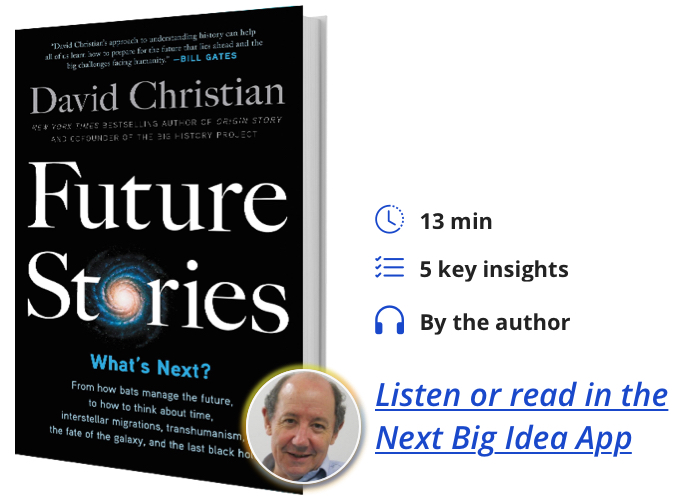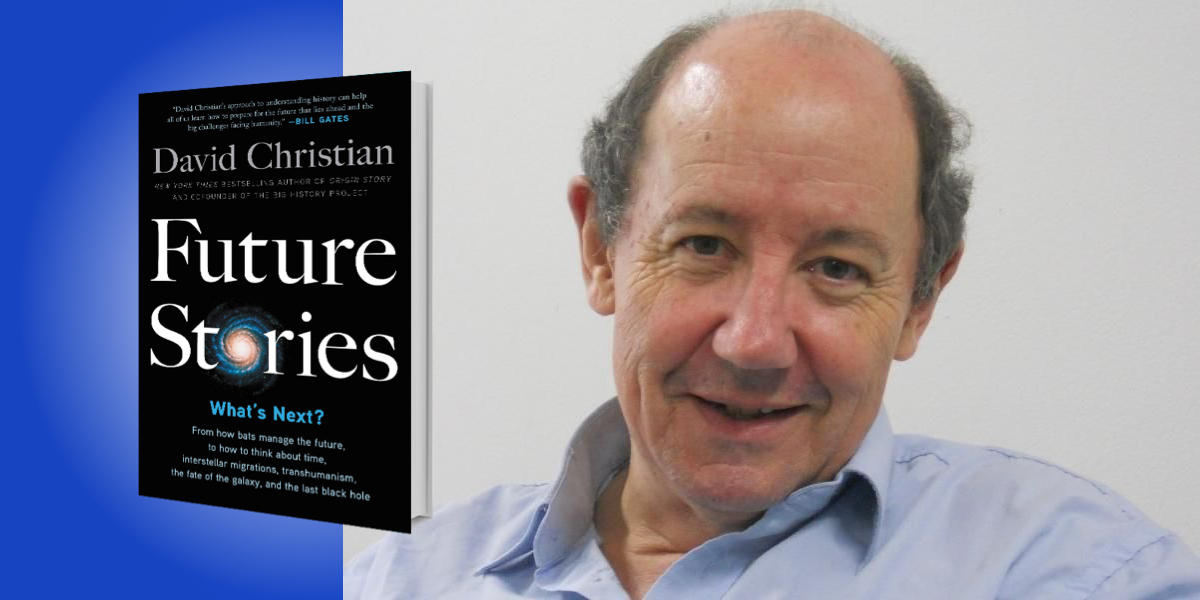David Christian is a Professor Emeritus at Macquarie University, where he was formerly a Distinguished Professor of History and the director of the Big History Institute. He cofounded the Big History Project with Bill Gates, and his TED Talk has been viewed over 20 million times.
Below, David shares 5 key insights from his new book, Future Stories: What’s Next? Listen to the audio version—read by David himself—in the Next Big Idea App.

1. We’ll spend the rest of our lives in the future.
To paraphrase the futurist Nicholas Rescher, from now on, every second of your life will be lived in the future. That’s why it’s worth studying carefully. Remarkably, we don’t teach how to study the future in most schools and universities. We all learn how to wing it, how to use more or less instinctive mechanisms to prepare for the future. But with a bit of thought and study, we can do better than that—and get a bit more control over our futures.
2. The future is unknowable.
Before the 20th century, modern science was pretty deterministic. Newton and those who came after him believed that our uncertainty about the future arose mainly from ignorance so that, with more information and better science, we should be able to forecast the future much better. But today’s science is less optimistic and more probabilistic; it argues that the future really is open in some respects. That means that there is some “free play” in the universe, as the philosopher William James put it, such that we can never forecast with certainty. That’s the bad news. But the good news is that this “free play” allows the ideas of free will and moral responsibility. We (and indeed all living organisms) can influence the future to a small degree, so we have an obligation to do so as skillfully as we can and with moral responsibility.
“We (and indeed all living organisms) can influence the future to a small degree, so we have an obligation to do so as skillfully as we can and with moral responsibility.”
3. Our only clues about likely futures lie in the past.
It’s a profound paradox: looking forward we are blind, but when we look back into the past, there are things to be seen. In Dante’s Inferno, soothsayers are punished in Hell by having their heads twisted backwards to the past; it’s a symbolic representation of the state we are all in, because the past does contain hints about the more likely futures. So we prepare for the future by looking backwards, which accounts for some of the exhilaration and terror of living. It’s a bit like driving a race car by looking in the rearview window. How do we, and in fact all living organisms, manage that remarkable feat?
4. To prepare for the future, we study regular trends in the past.
All living organisms are competent forecasters. They are equipped to forecast futures with a better-than-random success rate, and they do so by studying trends in the past, like those who bet on horses. This is the single most important principle of forecasting. Amidst all the noise and random chaos of ordinary life, some trends are slightly more regular than others. Would you put your money on the horse that has won eight out of 10 of its last races, or on the horse that has come last in its last eight races?
As we study the past, we focus mainly on those trends that are regular enough to allow pretty confident predictions. Sometimes, though, no clear trends are apparent, and we have to do what we can with less regular trends. These include most trends that are shaped by the will of individual humans, which is why political forecasting or economic forecasting is so hard—the decisions of humans are erratic and unpredictable.
“All living organisms are competent forecasters. They are equipped to forecast futures with a better-than-random success rate, and they do so by studying trends in the past.”
All living organisms study regular trends in the past as they prepare for the future. If I’m a thirsty impala, I’ll probably be interested in how often hungry lions turn up at the nearest waterhole. Future Stories explores how bacteria generate their own stories about likely futures using elaborate biochemical computers; it explores the complex flows of information and decision-making that plants use as they decide when to flower or when to drop their leaves; and it looks at the staggeringly complex neurological computers that all animals carry in their heads, computers that allow them to select from many different stories about possible futures.
5. To prepare for distant futures, we must study very large trends in the past.
If we want clues to the distant future, to the fate of our great-great-great-grandchildren and their children, we must study the past at large scales and across many disciplines. So much study of the past is on scales of a few decades, or a few centuries at most. But to really understand distant futures, we need to look for regular trends reaching over thousands, even millions of years. That’s what climate scientists do, and the scientists who study how life has evolved and changed in the course of planetary history. Can we find regular trends in the evolution of human technologies and human societies over hundreds of thousands of years? Few historians ask such questions, but if you look for them, you can find trends that may offer hints about the future.
“To really understand distant futures, we need to look for regular trends reaching over thousands, even millions of years.”
One is the remarkable trend of scientific and technological creativity that is apparent in all of human history. It’s a trend not matched in the history of any other species that has ever existed, and it suggests that we should expect humans to be as creative in the future as in the past, even as they tackle new problems such as climate change or the threat of nuclear war. Another trend as old as our species is migration. Our technological creativity explains why humans are continually exploring new environments and new possible homes. That trend makes it highly likely that some humans will eventually migrate beyond Earth to other planets in the Solar System—and perhaps even farther, to other star systems.
There are no guarantees, of course; we can never have certainty about the future. But we do know how studying the past can improve our chances of reaching good futures. That is why it is so important when thinking about the next hundred years or so, to take a deep view of human history. That’s what the new discipline of “big history” does. It explores the past of humanity, planet Earth, and the universe as a whole, looking for the very longest of trends—because they are the ones that may provide some guidance about the distant future, the future world of our grandchildren and their children.
To listen to the audio version read by author David Christian, download the Next Big Idea App today:































